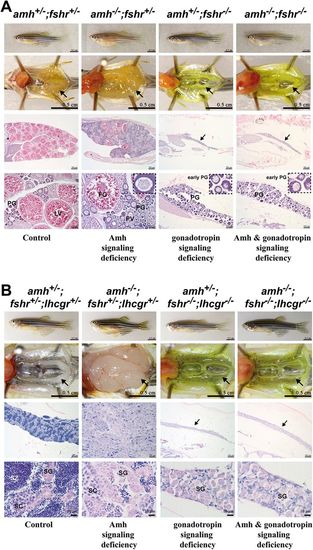Fig. 2
- ID
- ZDB-FIG-210205-19
- Publication
- Zhang et al., 2020 - Genetic evidence for Amh modulation of gonadotropin actions to control gonadal homeostasis and gametogenesis in zebrafish and its noncanonical signalling through Bmpr2a receptor
- Other Figures
- All Figure Page
- Back to All Figure Page
|
Evidence for involvement of gonadotropin signaling in amh deficiency-induced gonadal hypergrowth and dysfunctional gametogenesis. (A) Ovaries of different genotypes at 5?mpf. The amh single mutation (amh?/?;fshr+/?) caused ovarian hypertrophy with accumulation of PG follicles, whereas the fshr single mutant (amh+/?;fshr?/?) showed ovarian hypotrophy with much fewer, underdeveloped PG follicles only. Double mutation of amh and fshr (amh?/?;fshr?/?) completely abolished the phenotype of amh mutant. (B) Testes of different genotypes at 5?mpf. The amh mutation alone (amh?/?;fshr+/?;lhcgr+/?) caused testicular hypertrophy and dysfunctional spermatogenesis with limited meiosis, whereas the loss of gonadotropin signaling in the fshr and lhcgr double mutant (amh+/?;fshr?/?;lhcgr?/?) led to testicular hypotrophy and dysfunctional spermatogenesis, with no meiosis. The loss of all the three genes in the triple knockout (amh?/?;fshr?/?;lhcgr?/?) completely abolished the hypertrophic phenotype of amh mutation. LV, late vitellogenic; SC, spermatocytes; SG, spermatogonia; SZ, spermatozoa. Arrows indicate ovaries or testes. |

